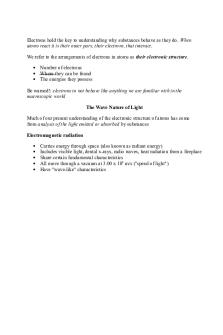Summary Chapter unique features of electronic commerce. PDF

| Title | Summary Chapter unique features of electronic commerce. |
|---|---|
| Author | ayman hussain |
| Course | Electrical Actuators |
| Institution | الجامعة الأردنية |
| Pages | 1 |
| File Size | 34.3 KB |
| File Type | |
| Total Downloads | 20 |
| Total Views | 158 |
Summary
Chapter 10- E-commerce .
...
Description
Chapter Summary 1. What are the unique features of electronic commerce (e-commerce), digital markets, and digital goods? E-commerce involves digitally enabled commercial transactions between and among organizations and individuals. Unique features of e-commerce technology include ubiquity, global reach, universal technology standards, richness, interactivity, information density, capabilities for personalization and customization, and social technology. Digital markets are said to be more “transparent” than traditional markets, with reduced information asymmetry, search costs, transaction costs, and menu costs, along with the ability to change prices dynamically based on market conditions. Digital goods, such as music, video, software, and books, can be delivered over a digital network. Once a digital product has been produced, the cost of delivering that product digitally is extremely low. 2. What are the principal e-commerce business and revenue models? E-commerce business models are electronic retailers (e-tailers), transaction brokers, market creators, content providers, community providers, service providers, and portals. The principal e-commerce revenue models are advertising, sales, subscription, free/freemium, transaction fee, and affiliate. 3. How has e-commerce transformed marketing? The Internet provides marketers with new ways of identifying and communicating with millions of potential customers at costs far lower than traditional media. Crowdsourcing utilizing “the wisdom of crowds” helps companies learn from customers in order to improve product offerings and increase customer value. Behavioural targeting techniques increase the effectiveness of banner, rich media, and video ads. 4. How has e-commerce affected business-to-business (B2B) transactions? B2B e-commerce generates efficiencies by enabling companies to locate suppliers, solicit bids, place orders, and track shipments in transit electronically. Net marketplaces provide a single, digital marketplace for many buyers and sellers. Private industrial networks link a firm with its suppliers and other strategic business partners to develop highly efficient and responsive supply chains. 5. What is the role of mobile commerce (m-commerce) in business, and what are the most important m-commerce applications? M-commerce is especially well suited for location-based applications, such as finding local hotels and restaurants, monitoring local traffic and weather, and providing personalized location-based marketing. Mobile phones and handhelds are being used for mobile bill payment, banking, securities trading, transportation schedule updates, and downloads of digital content, such as music, games, and video clips. M-commerce requires wireless portals and special digital payment systems that can handle micropayments. 6. What issues must be addressed when building an e-commerce Web site? Building a successful e-commerce site requires a clear understanding of the business objectives to be achieved by the site and selection of the right technology to achieve those objectives. E-commerce sites can be built and hosted in-house or partially or fully outsourced to external service providers....
Similar Free PDFs

Summary Electronic Commerce
- 13 Pages

Electronic and Mobile Commerce
- 7 Pages

Review on Electronic Commerce
- 10 Pages

Features of Connected Speech
- 9 Pages

Features of dramatic texts
- 3 Pages

Features of Punjabi culture
- 3 Pages

Salient Features of 80286
- 13 Pages

Chapter 7 - E-commerce
- 47 Pages

Chapter 8 E Commerce
- 62 Pages

Chapter 5 - E-commerce
- 45 Pages

Electronic Structure of Atoms
- 34 Pages
Popular Institutions
- Tinajero National High School - Annex
- Politeknik Caltex Riau
- Yokohama City University
- SGT University
- University of Al-Qadisiyah
- Divine Word College of Vigan
- Techniek College Rotterdam
- Universidade de Santiago
- Universiti Teknologi MARA Cawangan Johor Kampus Pasir Gudang
- Poltekkes Kemenkes Yogyakarta
- Baguio City National High School
- Colegio san marcos
- preparatoria uno
- Centro de Bachillerato Tecnológico Industrial y de Servicios No. 107
- Dalian Maritime University
- Quang Trung Secondary School
- Colegio Tecnológico en Informática
- Corporación Regional de Educación Superior
- Grupo CEDVA
- Dar Al Uloom University
- Centro de Estudios Preuniversitarios de la Universidad Nacional de Ingeniería
- 上智大学
- Aakash International School, Nuna Majara
- San Felipe Neri Catholic School
- Kang Chiao International School - New Taipei City
- Misamis Occidental National High School
- Institución Educativa Escuela Normal Juan Ladrilleros
- Kolehiyo ng Pantukan
- Batanes State College
- Instituto Continental
- Sekolah Menengah Kejuruan Kesehatan Kaltara (Tarakan)
- Colegio de La Inmaculada Concepcion - Cebu




